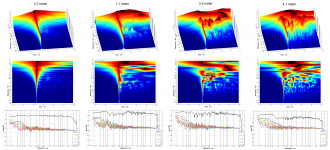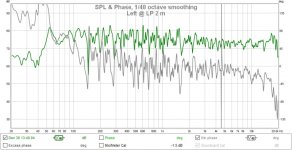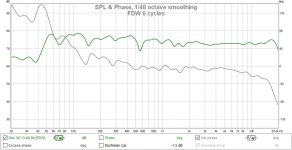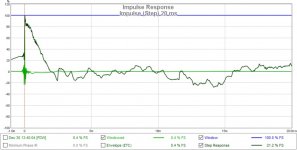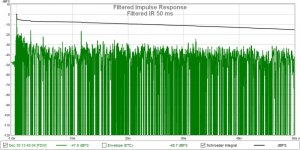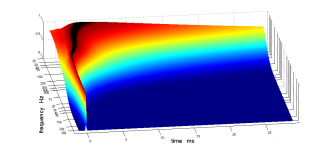I have heard the G1s. They are absolutely fantastic speakers with seemingly infinite dynamic range and no noticeable coloration. They were driven by Devialet amplifiers.
I must point out that in the 3 best systems I have heard (G1 system being best), a lot of effort was made to make the room as acoustically blameless as resources would allow. Additionally, in the G1 system there was room correction (Dirac) applied. My observation is that it is a waste of money to buy the best speakers you can afford, while neglecting the room acoustics. I heard the Vivid G1s both before and after room treatment. "Before" you could tell that the speakers were something special, but that was nowhere near how they sounded after acoustic treatment and digital room correction (the latter in the low frequency region) was implemented.
Distortion and/or dynamic compression - that provide clues as to how loud the music is playing - was so low in this system that you could listen at excessively high volume levels and not be aware of it. The first clue I got was when I stepped out of the room and tried to start a conversation with someone there...
oh my gosh! This is amazing!!!
My room is acoustically treated so I wouldn't have these problems and I totally agree with you, it's a waste to have even a 25K speaker like mine, let alone a 68K without having done proper room correction!
Regarding your feedback it is very interesting, since it is exactly what's written on many reports from all over the world!
Last, Devialet is a poor amplification compared to others, and yet the speaker is so great to still allow the max to come out from the upstream chain!
Very remarkable! Thanks for sharing your experience!
Erik what are you even talking about??
You are bashing so badly about B&W and you haven't even had a chance to listen to the Sig800 you talk so bad about, so how can you say that??!!!!
.....
.....Last, Devialet is a poor amplification compared to others, and yet the speaker is so great to still allow the max to come out from the upstream chain!
Very remarkable! Thanks for sharing your experience!
Seems @Stefanoo/eriksquires step on each others feet regarding taste in general and have strong opinions cut out.
Inspired Shaun words about real room acoustics and how they influence suggest @Stefanoo/eriksquires take duel not based on any other reviewers meaning brand or cost for system components but show what acoustics you actual have in listening area for each of your systems and base your meanings about how a system is good quality or flawed. Benchmark your system acoustics at sweet spot with APL_TDA trial version and share plots posted here, because think that would make everybody here wiser what you are used to in acoustic performance and we can probably take new discussions from there and learn from that.
APL_TDA trail version is available here: Acoustic Power Lab :: Home
Attachments
BYRTT,
that is really nice idea. What do I have to do? My room is acoustically treated with tubes and panels and ceiling clouds 😉 Please tell me how I need to take measurements and I can do that over the weekend!
I think your idea is really good! Also, if I am not wrong, I recall you are an expert in acoustic and speaker design, is that correct? If so you have to guide me through the measurements as I don't have the same level of expertise you have in this area!
that is really nice idea. What do I have to do? My room is acoustically treated with tubes and panels and ceiling clouds 😉 Please tell me how I need to take measurements and I can do that over the weekend!

I think your idea is really good! Also, if I am not wrong, I recall you are an expert in acoustic and speaker design, is that correct? If so you have to guide me through the measurements as I don't have the same level of expertise you have in this area!
Last edited:
This thread might help a bit:
http://www.diyaudio.com/forums/multi-way/285628-apl-tda-acoustic-loudspeaker-analyzing-software.html
or this one (started by the author of this software package)
http://www.diyaudio.com/forums/full-range/284916-room-correction-speaker-correction-what-can-we-do-dsp-power-now-availabl.html
Basically, download the APL_TDA demo software and download and install the required Mathworks Matlab compiler runtime (MCR) 2013a 8.1 according to your operating system type, Windows 32 or 64bit! found on the right side of the page.
Demo APL_TDA download
Next run the software and start measuring at the listening position, use either 48.0 kHz or 96.0 kHz sample rate.
You can use screen grabs to capture the results.
http://www.diyaudio.com/forums/multi-way/285628-apl-tda-acoustic-loudspeaker-analyzing-software.html
or this one (started by the author of this software package)
http://www.diyaudio.com/forums/full-range/284916-room-correction-speaker-correction-what-can-we-do-dsp-power-now-availabl.html
Basically, download the APL_TDA demo software and download and install the required Mathworks Matlab compiler runtime (MCR) 2013a 8.1 according to your operating system type, Windows 32 or 64bit! found on the right side of the page.
Demo APL_TDA download
Next run the software and start measuring at the listening position, use either 48.0 kHz or 96.0 kHz sample rate.
You can use screen grabs to capture the results.
Last edited:
Stefanoo,
Stereophile loves the B&W's. They can. I don't mind. They are not neutral at all. In the same price range if I had to buy, I would buy Magico long long before B&W. B&W went from neutral and boring as can be with the real Nautilus (perhaps the "boring" was due to Krell???) to "Not in my living room."
I have no opinion on Vivid. I've never heard them. They are pretty and huge and I wish I could afford the living room to do them justice, but have no idea about the sound.
Best,
Erik
Stereophile loves the B&W's. They can. I don't mind. They are not neutral at all. In the same price range if I had to buy, I would buy Magico long long before B&W. B&W went from neutral and boring as can be with the real Nautilus (perhaps the "boring" was due to Krell???) to "Not in my living room."
I have no opinion on Vivid. I've never heard them. They are pretty and huge and I wish I could afford the living room to do them justice, but have no idea about the sound.
Best,
Erik
I should also say, that B&W's approach to their house sound is kind of madenning. B&W has astoundingly capable driver designers and manufacturers but then puts it all together in such a weird way.
On the positive side, there's infinite loading, or drivers without surrounds, woven Kevlar cones (back when that was special) not to mention the use of top notch crossover components from Mundorf.
What a great sounding recipe, right? But put it together with their odd treble / midrange phase matching, and their chosen, duble treble hump "house curve" and it's quite infuriating. It's like seeing prime rib get turned into a Burrito Supreme.
Interestingly, I've seen a similar EQ curve from some of the Focals (the profile line) which also advanced the tweeter significantly. In fact, I just realized I should go compare them as well. << sigh>>
Again, I don't care if you like them. I'm just explaining how I can find such beutiful and expensive speakers so frustrating.
Best,
Erik
On the positive side, there's infinite loading, or drivers without surrounds, woven Kevlar cones (back when that was special) not to mention the use of top notch crossover components from Mundorf.
What a great sounding recipe, right? But put it together with their odd treble / midrange phase matching, and their chosen, duble treble hump "house curve" and it's quite infuriating. It's like seeing prime rib get turned into a Burrito Supreme.
Interestingly, I've seen a similar EQ curve from some of the Focals (the profile line) which also advanced the tweeter significantly. In fact, I just realized I should go compare them as well. << sigh>>
Again, I don't care if you like them. I'm just explaining how I can find such beutiful and expensive speakers so frustrating.
Best,
Erik
Last edited:
Stefanoo,
Stereophile loves the B&W's. They can. I don't mind. They are not neutral at all. In the same price range if I had to buy, I would buy Magico long long before B&W. B&W went from neutral and boring as can be with the real Nautilus (perhaps the "boring" was due to Krell???) to "Not in my living room."
I have no opinion on Vivid. I've never heard them. They are pretty and huge and I wish I could afford the living room to do them justice, but have no idea about the sound.
Best,
Erik
Erik,
honestly I am lost! I don't know which one you heard and which one you are just taking a guess!!!
Provided I am sure since the way you bash highly regarded high end equipment such as Krell and B&W Nautilus that you must have yourself an incredible sound system which surpasses everything I have listen to.
If you like Magico speakers, then I have to say you have very, very strange listening preferences.
You know that magico spend more on marketing and advertising then they do in making good speakers?
Beside the last huge monstrosity horn loaded I haven't listened, I have pretty much listened to almost all magicos, from their 20K up to 300K...and they all pretty much, more or less, suck!!
They range from a muffled sound with lack of transparency to a ear piercing shrill response.
I believe this is a good example of flat frequency response with very poor sounding product!!!
I would almost say how you dare comparing the Nautilus to these porr shoe boxes from Magico?
Please clear once for all what's your system and listening room and if you have personally listened to the Sig800 that you have been bashing since the first post here.
Stereophile likes B&W and so many other speakers. I honestly give a crap of what other magazines think about something unless I personally have listened to the product under review.
It is for me just fun reading reviews impressions they have and it's more fun to validate their statements on the listening experience.
If I were you I would necessary worry less about the frequency response and listen to the product with an open mind.
Like you said B&W uses top notch drivers, crossover parts and cabinet and I can guarantee you the sound of the sig800 is extremely good.
I am not claiming it is the best of all the speakers out there and I am sure there is better out there, all I can say is listen to the sig800 in a proper setup with an amp capable of driving them and you will be surprised.
About Giya, I have not listened myself either and I really look forward ti listening to those speakers soon. Too bad if I like them, I will have to wait quite a bit to save up funds to buy them and it won't be tomorrow for sure!
This thread might help a bit:
http://www.diyaudio.com/forums/multi-way/285628-apl-tda-acoustic-loudspeaker-analyzing-software.html
or this one (started by the author of this software package)
http://www.diyaudio.com/forums/full-range/284916-room-correction-speaker-correction-what-can-we-do-dsp-power-now-availabl.html
Basically, download the APL_TDA demo software and download and install the required Mathworks Matlab compiler runtime (MCR) 2013a 8.1 according to your operating system type, Windows 32 or 64bit! found on the right side of the page.
Demo APL_TDA download
Next run the software and start measuring at the listening position, use either 48.0 kHz or 96.0 kHz sample rate.
You can use screen grabs to capture the results.
Thank you for pointing this out. I will give a reading over the long weekend and I download the program and try to get things setup to make the measurements.
Erik: are you up for the duel?
 😀😀😀
😀😀😀This thread might help a bit:
http://www.diyaudio.com/forums/multi-way/285628-apl-tda-acoustic-loudspeaker-analyzing-software.html
or this one (started by the author of this software package)
http://www.diyaudio.com/forums/full-range/284916-room-correction-speaker-correction-what-can-we-do-dsp-power-now-availabl.html
Basically, download the APL_TDA demo software and download and install the required Mathworks Matlab compiler runtime (MCR) 2013a 8.1 according to your operating system type, Windows 32 or 64bit! found on the right side of the page.
Demo APL_TDA download
Next run the software and start measuring at the listening position, use either 48.0 kHz or 96.0 kHz sample rate.
You can use screen grabs to capture the results.
wesayso
I just started reading the thread, unfortunately the reading is a bit more complex than I thought it was going to....so it will take me few days to go through it.
Do you want to see the frequency response of my room with calibrated microphone using REW tool? Or are you interested in the waterfall diagram?
Since I am more familiar with REW and have already the software, just tell me what measurement and settings I need to have and I will do that and post the results.
THX.
Stefano.
agree with stefano, magico is overpriced marketing driven stuff. they are decent, but B&W are simply betterI should also say, that B&W's approach to their house sound is kind of madenning. B&W has astoundingly capable driver designers and manufacturers but then puts it all together in such a weird way.
On the positive side, there's infinite loading, or drivers without surrounds, woven Kevlar cones (back when that was special) not to mention the use of top notch crossover components from Mundorf.
What a great sounding recipe, right? But put it together with their odd treble / midrange phase matching, and their chosen, duble treble hump "house curve" and it's quite infuriating. It's like seeing prime rib get turned into a Burrito Supreme.
Interestingly, I've seen a similar EQ curve from some of the Focals (the profile line) which also advanced the tweeter significantly. In fact, I just realized I should go compare them as well. << sigh>>
Again, I don't care if you like them. I'm just explaining how I can find such beutiful and expensive speakers so frustrating.
Best,
Erik
I laugh hard though when I read that my cheap jbl lsr32/6332 were preffered by a danish moderator vs the nautilus 802
vivid giya would likely be my pick at 30k. but id have to compare directly to ATC SCM100asl with the new atc tweeter!
Last edited:
.....I just started reading the thread, unfortunately the reading is a bit more complex than I thought it was going to....so it will take me few days to go through it.
.....
Hi Stefanoo
Cool you will try it out, software is made for pros with good acoustics and audio understanding so help is few and license cost for pros is steep seen with diy eyes but should you end like to have full functions updated version Raimonds Skuruls offered us at diyA license on par student costs over at this diyA thread http://www.diyaudio.com/forums/full...eaker-correction-networks-27.html#post4583863 .
Can i help regarding installation you need three files as seen below, install Matlab Compiler Runtime and install APL_TDA demo.
1. If your Windows OS is 64bit download either 32 or 62 bit version of Matlab Compiler Runtime and APL_TDA and if Windows is 32bit get 32bit version of those two installers.
2. Rightclick Matlab Compiler Runtime and pick run as administrator and follow setup instructions.
3. Rightclick APL_TDA demo and pick run as administrator and follow setup instructions.
4. Go into folder you installed APL_TDA and find the programs exe file then rightclick it and run as administrator should get you going, only thing left before a sweep is adjust sound card settings up in left corner. Although important detail to avoid samplerate mismatch distortion is in Windows sound control panel go adjust sound cards input and output to lock at either 48 or 96kHz that is the two numbers supported into APL_TDA settings too.
Should you like i can share these three files via OneDrive on request.
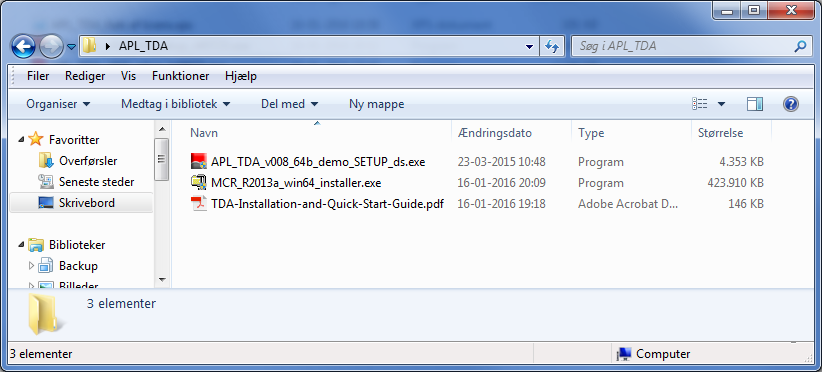
wesayso
I just started reading the thread, unfortunately the reading is a bit more complex than I thought it was going to....so it will take me few days to go through it.
Do you want to see the frequency response of my room with calibrated microphone using REW tool? Or are you interested in the waterfall diagram?
Since I am more familiar with REW and have already the software, just tell me what measurement and settings I need to have and I will do that and post the results.
THX.
Stefano.
Hi Stefano, any and every measurement can help us all learn. I hope you can get APL_TDA to run using the above post by BYRTT. If you were to run REW some things would be fun to see, regarding speaker and room integration.
Measurement taken with microphone at the listening position.
- a FR plot showing phase 1/48 oct smoothing if needed.
- The same FR plot but this time with a frequency dependent window of 6 cycles, no smoothing.
- Distortion plot showing the complete 20-20K range.
- an IR, normalised to 100% and set up in %FS in upper left corner. 0 to 20 ms scale visible on bottom -100% to +120% on left side
- Filtered IR (one tab further) set upper left to "dB FS", the first 50 ms being of interest (bottom scale).
- an early waterfall plot, showing the first wave front that hits our ears. Set it to these variables:

- RT60 data
The above, together with an APL_TDA plot shows us a lot of data how the speaker interacts with the room, but also shows us useful data of that first wave hitting our ears. An additional wavelet in REW is interesting, but APL_TDA tells us so much more.
The mentioned plots would be the first thing I look at. But I do look at many more little details. This gives a good overall first impression of the speaker and it's room integration.
This is the data I would hope everyone would post. Just as a learning opportunity for us all. I promise I will not be rude or harsh in comments in any way to what I see. We might help each other get to a better sound here.
I really appreciate you're willing to do this. As said, we can all learn something here. We should all share info like this to get ahead and move forward.
I noticed Erik was still stuck on repeat. 😱 I do hope if you post this data, he will do the same on his end. It might just end the bickering 🙂.
Last edited:
Hi Stefanoo
Cool you will try it out, software is made for pros with good acoustics and audio understanding so help is few and license cost for pros is steep seen with diy eyes but should you end like to have full functions updated version Raimonds Skuruls offered us at diyA license on par student costs over at this diyA thread http://www.diyaudio.com/forums/full...eaker-correction-networks-27.html#post4583863 .
Can i help regarding installation you need three files as seen below, install Matlab Compiler Runtime and install APL_TDA demo.
1. If your Windows OS is 64bit download either 32 or 62 bit version of Matlab Compiler Runtime and APL_TDA and if Windows is 32bit get 32bit version of those two installers.
2. Rightclick Matlab Compiler Runtime and pick run as administrator and follow setup instructions.
3. Rightclick APL_TDA demo and pick run as administrator and follow setup instructions.
4. Go into folder you installed APL_TDA and find the programs exe file then rightclick it and run as administrator should get you going, only thing left before a sweep is adjust sound card settings up in left corner. Although important detail to avoid samplerate mismatch distortion is in Windows sound control panel go adjust sound cards input and output to lock at either 48 or 96kHz that is the two numbers supported into APL_TDA settings too.
Should you like i can share these three files via OneDrive on request.

Byrtt,
thank you very much for your detailed post. Let me ask you:
what is the advantage of using this SW instead of REW?
REW is a proven free tool that doesn't require many other SW to be installed and it's widely used around the net and I am sure it can do all the basic measurements required to analyze room interaction.
Will this other tool offer a different set of measurements the other doesn't?
Look at these two plots,

And:

While looking similar, their function is not the same. Nor is the amount of info you can extract from it. Both have their own purpose to give information to it's user. I use both for different reasons. If I had to choose? It would be APL_TDA.
The Demo only requires one extra piece of software installed beside it's own installation. The other (third) file is a pdf. Even REW uses something else, it does use Java.
If you really want to see if all the hard work done to the room paid off, APL_TDA can tell you a lot. Pretty much the same info can be gained from REW, but it takes a lot of interpretation and shuffling trough tabs. Here you get a visual representation of that interpreted data. None of REW's outputs can give it to you this clear.

And:

While looking similar, their function is not the same. Nor is the amount of info you can extract from it. Both have their own purpose to give information to it's user. I use both for different reasons. If I had to choose? It would be APL_TDA.
The Demo only requires one extra piece of software installed beside it's own installation. The other (third) file is a pdf. Even REW uses something else, it does use Java.
If you really want to see if all the hard work done to the room paid off, APL_TDA can tell you a lot. Pretty much the same info can be gained from REW, but it takes a lot of interpretation and shuffling trough tabs. Here you get a visual representation of that interpreted data. None of REW's outputs can give it to you this clear.
Last edited:
Hi Stefano, any and every measurement can help us all learn. I hope you can get APL_TDA to run using the above post by BYRTT. If you were to run REW some things would be fun to see, regarding speaker and room integration.
Measurement taken with microphone at the listening position.
- a FR plot showing phase 1/48 oct smoothing if needed.
- The same FR plot but this time with a frequency dependent window of 6 cycles, no smoothing.
- Distortion plot showing the complete 20-20K range.
- an IR, normalised to 100% and set up in %FS in upper left corner. 0 to 20 ms scale visible on bottom -100% to +120% on left side
- Filtered IR (one tab further) set upper left to "dB FS", the first 50 ms being of interest (bottom scale).
- an early waterfall plot, showing the first wave front that hits our ears. Set it to these variables:

- RT60 data
The above, together with an APL_TDA plot shows us a lot of data how the speaker interacts with the room, but also shows us useful data of that first wave hitting our ears. An additional wavelet in REW is interesting, but APL_TDA tells us so much more.
The mentioned plots would be the first thing I look at. But I do look at many more little details. This gives a good overall first impression of the speaker and it's room integration.
This is the data I would hope everyone would post. Just as a learning opportunity for us all. I promise I will not be rude or harsh in comments in any way to what I see. We might help each other get to a better sound here.
I really appreciate you're willing to do this. As said, we can all learn something here. We should all share info like this to get ahead and move forward.
I noticed Erik was still stuck on repeat. 😱 I do hope if you post this data, he will do the same on his end. It might just end the bickering 🙂.
wesayso,
You are definitely very knowledgeable in this field! I think this is a much more productive discussion than just debating with other users over products they didn't even hear.
I also know that your intention is not to be rude but constructive and either way my room is heavily acoustically treated and I would enjoy understanding better how to improve it further and for anybody to take benefit from this discussion to improve their site as well.
I have trouble fully understanding the settings and how to get proper readings. If you have a Skype account or any other messaging tools, would it be possible to get together one of these days so you can navigate me through the options and setting to obtain the graphs you think are needed to run an analysis?
If so, please feel free to send me your contact at my email:
Stefano_rumori@yahoo.it
Look at these two plots,

And:

While looking similar, their function is not the same. Nor is the amount of info you can extract from it. Both have their own purpose to give information to it's user. I use both for different reasons. If I had to choose? It would be APL_TDA.
The Demo only requires one extra piece of software installed beside it's own installation. The other (third) file is a pdf. Even REW uses something else, it does use Java.
If you really want to see if all the hard work done to the room paid off, APL_TDA can tell you a lot. Pretty much the same info can be gained from REW, but it takes a lot of interpretation and shuffling trough tabs. Here you get a visual representation of that interpreted data. None of REW's outputs can give it to you this clear.
ok you convinced me and thanks for your explanation. I will install the APL_TDA tool today.
What is the difference between free and license version and how much is the license version cost?
P.S. since I don't have your knowledge on acoustic aspect, the second plot really doesn't tell me much as opposed to the standard waterfall plot, but I know you know exactly what you are talking about and therefore I just trust your judgment!
REW measurements as per Ronald's
Sorry if not appropriate for this thread (moderator pls remove if needed) but since I have a fresh measurements I am posting them, following Ronald's parameters (4way: 2xSS21W8555 sub sealed/ 2x12 MCM 55-2982 OB upper bass/ Faital 6HX150 coax sealed mid/high; sub>upperbass 80Hz DCX; upperbass>mid 250 Hz DCX; mid>high 1K7 passive; all LR4 acoustic slopes)
Sorry if not appropriate for this thread (moderator pls remove if needed) but since I have a fresh measurements I am posting them, following Ronald's parameters (4way: 2xSS21W8555 sub sealed/ 2x12 MCM 55-2982 OB upper bass/ Faital 6HX150 coax sealed mid/high; sub>upperbass 80Hz DCX; upperbass>mid 250 Hz DCX; mid>high 1K7 passive; all LR4 acoustic slopes)
Attachments
Stefanoo,
Here is your target curve before room acoustics set in 🙂
Data is set as BW2 band-pass 32Hz-28kHz with IRR XO LR4 350Hz and LR2 4kHz.
Here is your target curve before room acoustics set in 🙂
Data is set as BW2 band-pass 32Hz-28kHz with IRR XO LR4 350Hz and LR2 4kHz.
Attachments
Last edited:
Stefanoo,
Here is your target curve before room acoustics set in 🙂
Data is set as BW2 band-pass 32Hz-28kHz with IRR XO LR4 350Hz and LR2 4kHz.
that's the ideal response...if you have that you live in a surreal world...

But isn't what you are plotting a waterfall graph that can be plot with any other SW including REW or is there something special about how the other tool plots it?
Tonight I am installing the SW on my laptop as per your instructions.
Can someone tell me the difference between free and license edition and how much the license for the program costs and if it is necessary?
agree with stefano, magico is overpriced marketing driven stuff. they are decent, but B&W are simply better
I laugh hard though when I read that my cheap jbl lsr32/6332 were preffered by a danish moderator vs the nautilus 802
vivid giya would likely be my pick at 30k. but id have to compare directly to ATC SCM100asl with the new atc tweeter!
Sorry I have missed your comment! Yes, it is kind of funny! The problem is that sometimes people perceived one thing better than the other without factoring in system and room.
For example, to properly drive a B&W 802, you will need a very powerful and high quality amplifier along with properly treated room, partnered with an equally capable source and preamplifier.
If any of these condition fails, then in my experience, sometimes the perception at first glance that a cheaper object might perform better can easily materialize.
Regarding the ATC, I never listened to them before, I don't doubt they are darn good....it's just that I would not spend personally that amount of money for speakers with that shape. To me the giya are a work of art just like the Nautilus. This is purely personal and I can understand that some people don't like the shape and form of either of them.
Unfortunately the Giya G1 is $68K as opposed to the $18K for the ATC. It would be almost unfair to compare the two objects.
Maybe a more apple to apple comparison would be to compare that speakers to my B&W which are in cost more similar.
EDIT: Just realized that the ATC have active amplification and crossover built in, that needs to be factored into the price. I have unfortunately some preconceptions against pre-amplified speakers, but it's not excluded that maybe if I listened to those I could change mind!
Last edited:
- Home
- Loudspeakers
- Multi-Way
- B&W Signature 800 upgrade diamond tweeter
